Armenia is an ancient country. According to some historians it is at least 2,500 years old. Others claim that it is about 3,500 or even 6,000 years old. Many traditions and customs have developed over these centureis. They changed, transformed, but survived and are kept by the people.
We have assembled a guide to Armenian holidays, rituals, customs and traditions. We've learned about local dishes, upbringing and mentality and wrote an article that will help you get to know and understand these people better. Note, although these traditions are still common, not every family adheres to them.
Contents
- Relationships, mentality
- Traditional dishes
- Traditional clothing
- Traditional dances
- Folk music
- Family traditions
- National holidays
Relationships, mentality
Greetings
Let's start our acquaintance with the traditions of Armenians with a greeting. When meeting in Armenia, it is customary for men to kiss on the cheek, because a kiss means that you are friends, you trust each other. Men also shake hands when meeting. From an Armenian you will hear not only “barev dzes” - “hello”, but also the question “vonts es?” - "How are you?" And not to ask in the answer is impolite. Also, referring to the interlocutor, they add the word "jan" to show respect, their good attitude, love. We have an entire chapter dedicated to this word. article.
If you want to know more words than just greetings, sign up for Armenian courses at language schools from the Move2Armenia catalog.
Relationship towards relatives
In Armenia family is one of the main values. Big holidays like Christmas are usually celebrated with relatives; the whole family gathers for feasts; relatives often visit each other. Young couples often choose to live with their parents even if they have enough money to live separately. Close friends are also considered a part of a family.
There is a special attitude towards elderly people in Armenia .They are deeply respected and assissted. Young people do not interrupt them, argue with them or make noise in their presence and, of course, they give way to elderly people and take care of them at the table. When an older person enters a room, it is customary in many families to stand up and not sit down while the older person is standing. Аdult children provide for their elderly parents.
There is an emotional attitude towards children. Families often have many children. They are considered a blessing from above, they are allowede to do almost everything. When parents walk with a child passers by may stop them, give the child a compliment, treat him or her with sweets and fruits. People are not afraid to leave children play on the playground near the house because they are always under the supervision of neighbors; the kids will not be offended.
Children's Day is widely celebrated in Armenia. Concerts are held in the squares, events are held in libraries, development centers, and in general a variety of entertainment is organized.
A man's status
The tradition of a special relationship towards a man is more preserved in the regions of Armenia, but not in large cities. Thus, the birth of a boy is considered a great joy in the family because it means that the family will continue. The perception of a man as a provider is still widespread. He is the head of the family and can forbid his wife to work. In conservative families and in the provinces it is customary that a man walks ahead of a woman, enters the room first, seeing him, women keep silent.
Attitude towards women
Women are respected in Armenia, it is not customary to speak rudely in their presence. Young people say that they rarely get aquainted with girls in public places, as they are afraid of the girls' older brothers.
The woman is often in charge of the household. In remote villages meekness and modesty are especially valued. A woman may wear closed clothes there; it is not customary to argue with a husband. However, this is rarely met in large cities.
Hospitality
One of the main Armenian traits that people around the world know about is hospitality. A foreigner, a new acquaintance will certainly be invited to the house and generously treated. Armenians say that a guest is sent by God. If the newcomer is given shelter, fed it will bring happiness to that house. Refusing an invitation is considered disrespectful. At feasts, according to custom, they can leave a place for an unexpected guest.
I would like to share my personal experience as well. When we arrived at an apartment in Armenia, the head of the block met us and invited for a beer.
Neighbours
The Armenian expression “A good neighbor is better than a close relative” speaks most clearly about their attitude towards neighbors. Neighbors may come to each other's place without warning and knocking at the door. They can meet daily for a cup of coffee and discuss the latest news.
Being late
One can rarely meet an Armenian who comes to a meeting on time. They are late for every meeting be it visiting one's place or some event. It is customary to be late for 15 minutes.
Love for their country and people
Armenians love and are proud of their country. They may be dissatisfied with the government, complain about difficult life situations, but this will not change their cordial attitude towards their homeland. Locals would certainly ask foreigners if they like Armenia, and at the same time they would tell what the country is famous for. Repatriates from all over the world come and stay in Armenia, who could never have lived here before.
Religion
Armenia is the first country to adopt Christianity (301), which they are very proud of. Most Armenians belong to Armenian Apostolic Church. Religious holidays are widely celebrated, which we will discuss below.
Armenians do not swear
In Armenia it is not customary to swear in public places, as girls can pass by, that is, someone's mothers, sisters, grandmothers. It is unacceptable that they hear not only swearing, but generally rude words. As for a swearing girl, it is considered as nonsense.
Horns instead of automotive lighting
Car enthusiasts who come to Armenia are surprised that drivers “communicate” with the help of horns instead of headlights or turn signals. This is why it is noisy on busy streets.
Chess and backgammon (nardi)
Chess is taught in schools, so every Armenian knows how to play chess, at least a little. Also, it is common to see people with backgammon in the yards. Armenians are famous for the art of making boards for chess and backgammon.

Traditional dishes
We have already talked about hospitality; a feast is its integral part. Meat dishes are always present during a traditional feast, they are served with a salad— akhtsan from tomatoes, cucumbers and greens, a variety of pickles, homemade cheeses and lavash. By the way, lavash (the thin Armenian bread) is included in the UNESCO Intangible Heritage List.
In general, Armenian dishes are fatty, high-calorie. They eat a lot of meat and bread. As in other hot countries, a lot of salt is used in cooking here. But in 2022 the Ministry of Health of Armenia forbade placing salt shakers on tables in restaurants and cafes, as they even consume too much salt.
One of the most famous Armenian dishes is shish kebab or khorovats. They even organize competitions among restaurants to see who can cook the best meat.
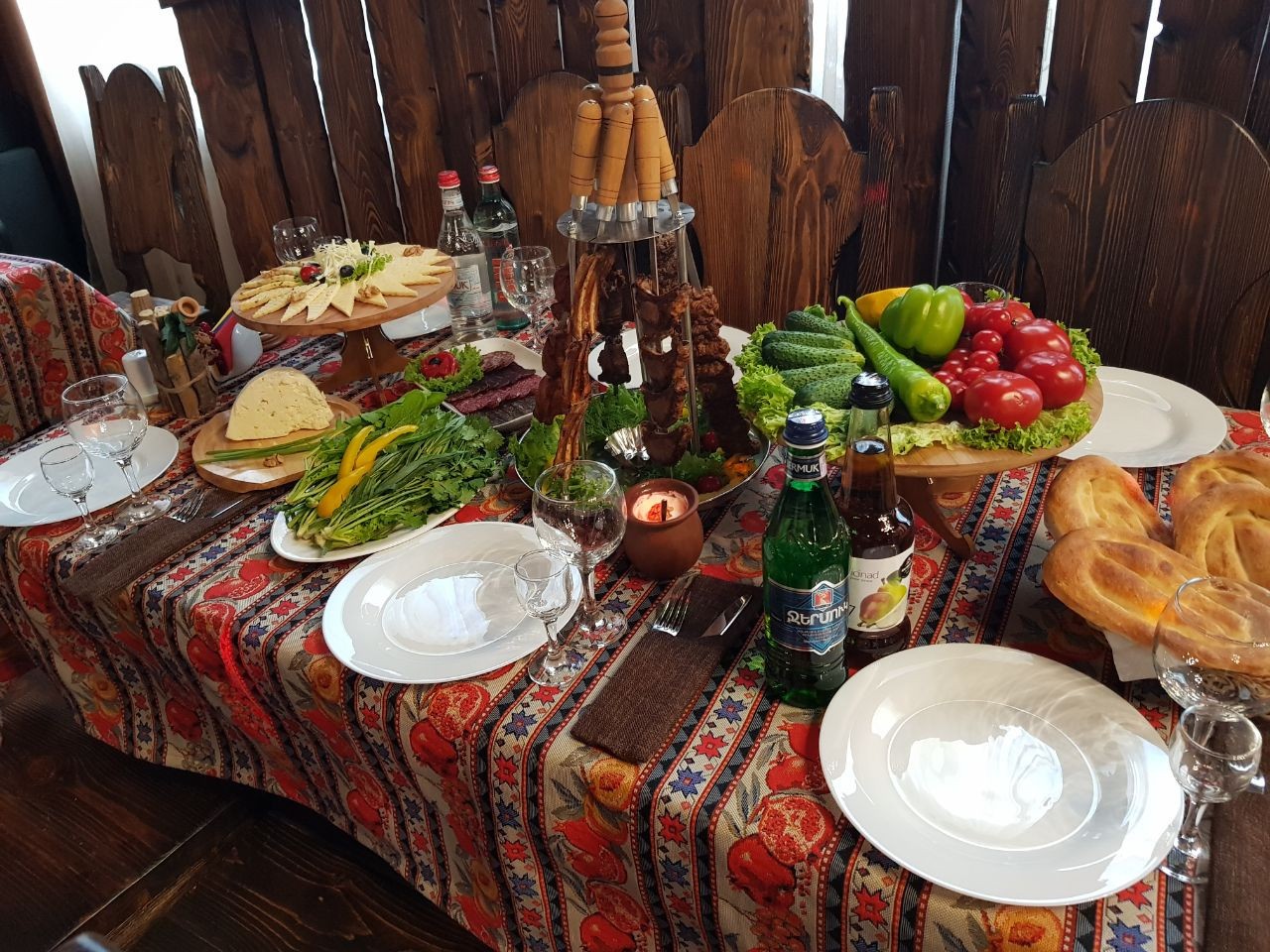
Traditional meat dishes:
Amich—poultry stuffed with dried fruits.
Hrisa—porridge with chicken.
Dolma, or rather tolma – minced meat with rice in grape leaves.
Kufta are tender meat balls, usually sliced.
Kyalla is a dish made from lamb or beef head. Traditionally it is prepared in Gyumri. Not even all modern Armenians dare to try kyalla because of its appearance. But those who dare say that this is a very tasty dish.
Lamajo is a flatbread stuffed with minced meat.
Separately, we will name soups, since they are also diverse in Armenia:
Aveluk. The soup is named after the main ingredient—aveluk or horse sorrel. Armenian cuisine often uses herbs that may be considered weed in other countries.
Bozbash is lamb soup.
Spas is a milk soup especially loved by Armenians.
Khashlama – veal soup with potatoes and vegetables.
Khash – beef broth, which is usually eaten in the morning in the cold months. Along with it they serve vodka, pickles, and crumble dry lavash inside. There is a joke connected with this soup. They say that he doesn’t like three “k”s: “kenats” – toast – supposedly they don’t say toasts with khash; cognac, because they drink vodka, and “kin” - for women, since khash is prepared by men.
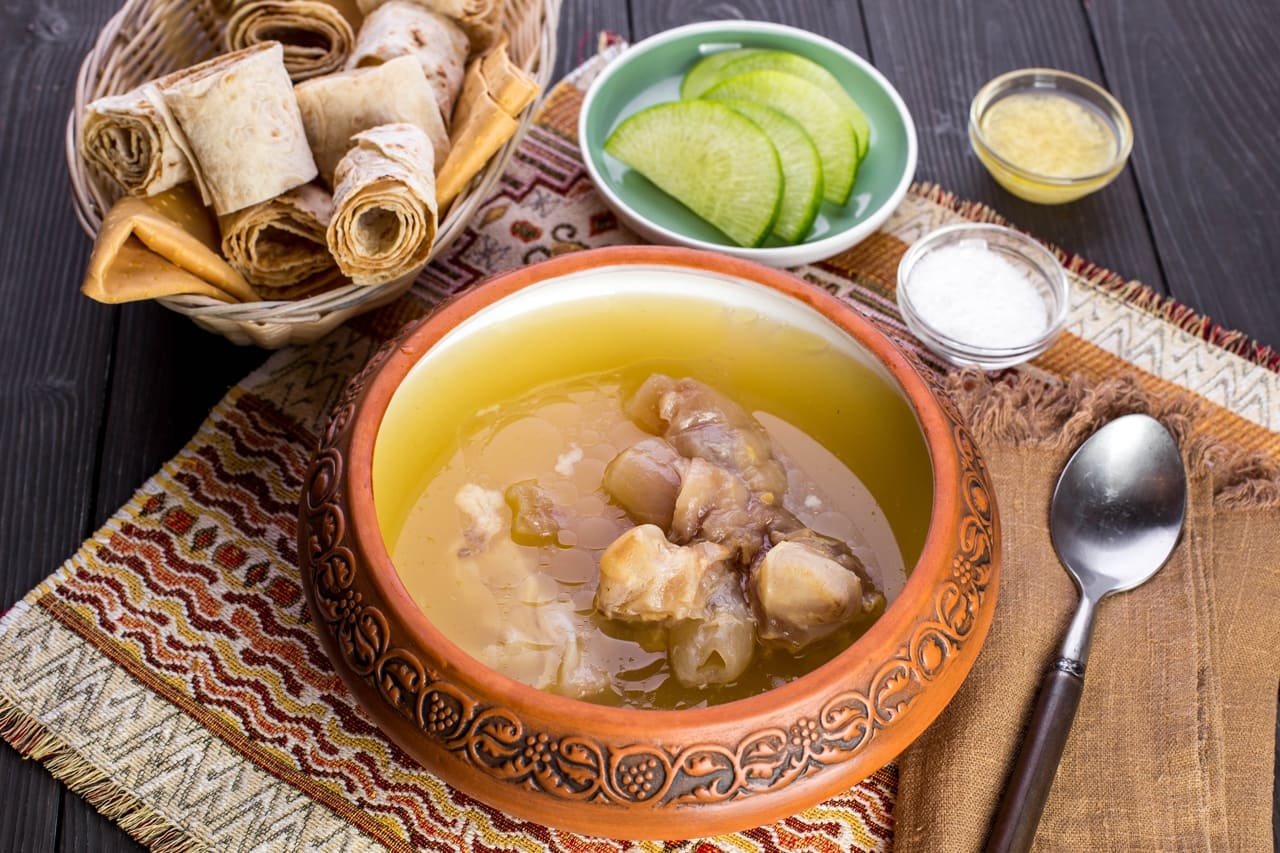
Vegetable dishes:
Zhengyalov hats—thin flatbreads with a lot of chopped greens.
Imam bayaldy—eggplant with vegetables and garlic-dill dressing. In Armenia, they are often put it in glass jars and save for winter.
Ghapama—stuffed pumpkin. Its filling can be called sweet pilaf. This is a festive dish, it is served at a wedding, Christmas or Easter.

Sweets and baked goods:
Barurik—a roll with nut filling.
Gata or kyata can remide of a pie or a cookie, as it is cooked differently depending on the region. It is filled with walnuts or butter with powdered sugar.
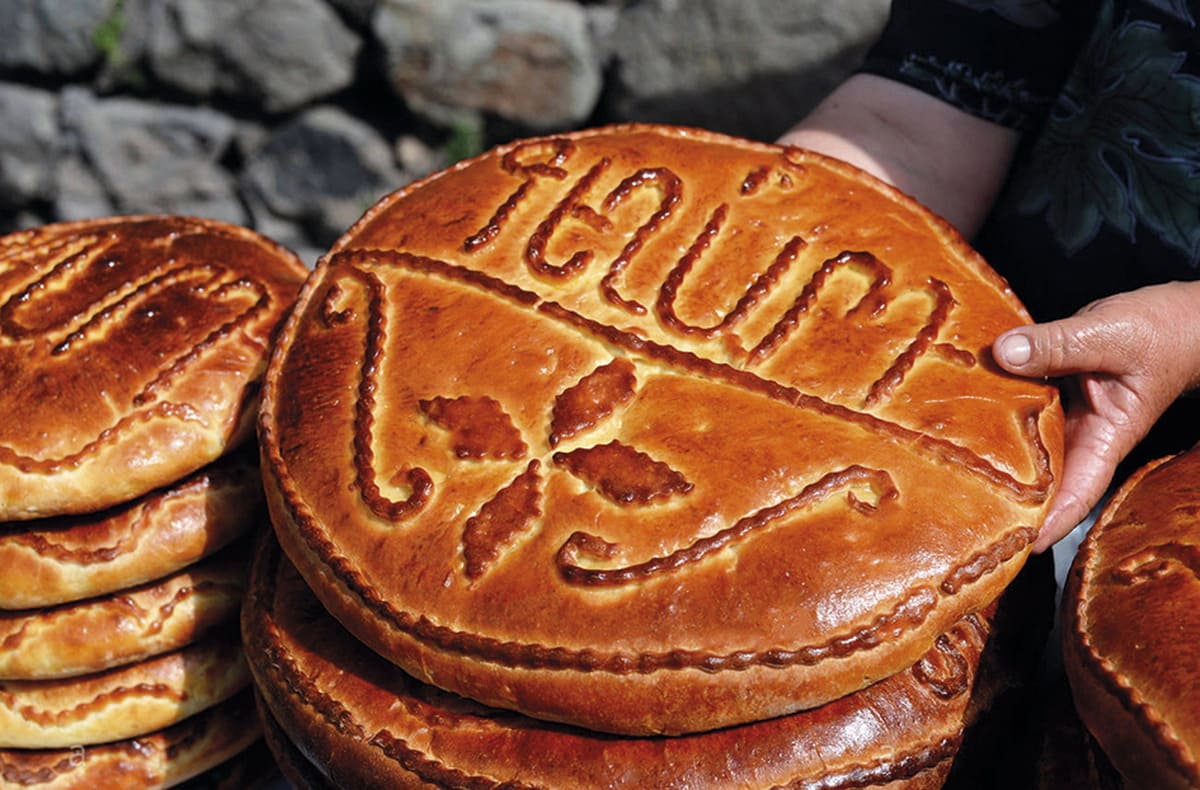
Cake "Mikado" consists of many thin sour cream cakes and chocolate custard with condensed milk. This is a real sweet bomb, but it is impossible to refuse it.
Nazuk is a pastry made from puff pastry. It can be both sweet and salty. It is traditionally prepared for Easter.
Sharots or sweet sujuk is an Armenian sweet, a relative of Georgian churchkhela.
Alani is dried peaches stuffed with nuts. As in sharots, the fruit is strung on a string.
Matnakash is a traditional oval bread with grooves in the middle. It has a crust outside, and a soft bun inside.
Mshosh porridge can be conditionally classified as sweet. This is a lentil dish with dried fruits and nuts. Sometimes they are replaced with vegetables.
Armenia is famous for its drinks. Tourists return home with bottles of the famous cognac “Ararat” and “Noah”. Armenia is also proud of its wine, not only grape wine, but also pomegranate. It is produced in many home wineries. At feasts you can find mulberry vodka “Artsakh”. While it is well known that Armenians love cognac and wine, not everyone knows about their special relationship with beer. But men love to get together over a glass of “Gyumri”, “Cilicia” or “Dilijan”.
Out of non-alcoholic drinks they choose mineral water "Jermuk". Tan—a fermented milk product is quite refreshing. It is estimated that on average every citizen of Armenia drinks 3.5 cups of coffee per day. They loved it here and prefer to cook it in a cezve on the sand. Often women tell fortunes on used coffee grounds.
You can even drink water from a tap in Armenia. Drinking fountains—pulpulaks are installed on the streets, which are real saviour during the heat. The expression: “Water is for the younger, the word is for the elder” is associated with pulpulak. As we have already said, the older generation in Armenia is respected, they are always supposed to speak first, as for children, they need to be given way to the water first.

Traditional clothing
Traditional Armenian clothing is called taraz. It varied from region to region, but the basic elements were similar. Women wore trousers, a shirt, put on a dress or caftan, an apron over it. On holidays, dresses were tied with a wide belt. The outfit was decorated with embroidery, braid, which, it was believed, protected from evil influences. It was possible to understand where the woman came from by her clothes. They also wore jewelry which showed family status.
The men's costume consisted of a shirt, trousers and a caftan, on which they put on a chukha - a Circassian coat below the knee made of sheep's wool and belted it.
Clothing was traditionally red, yellow, blue or purple. Ornaments were geometric, depicting greens or animals.
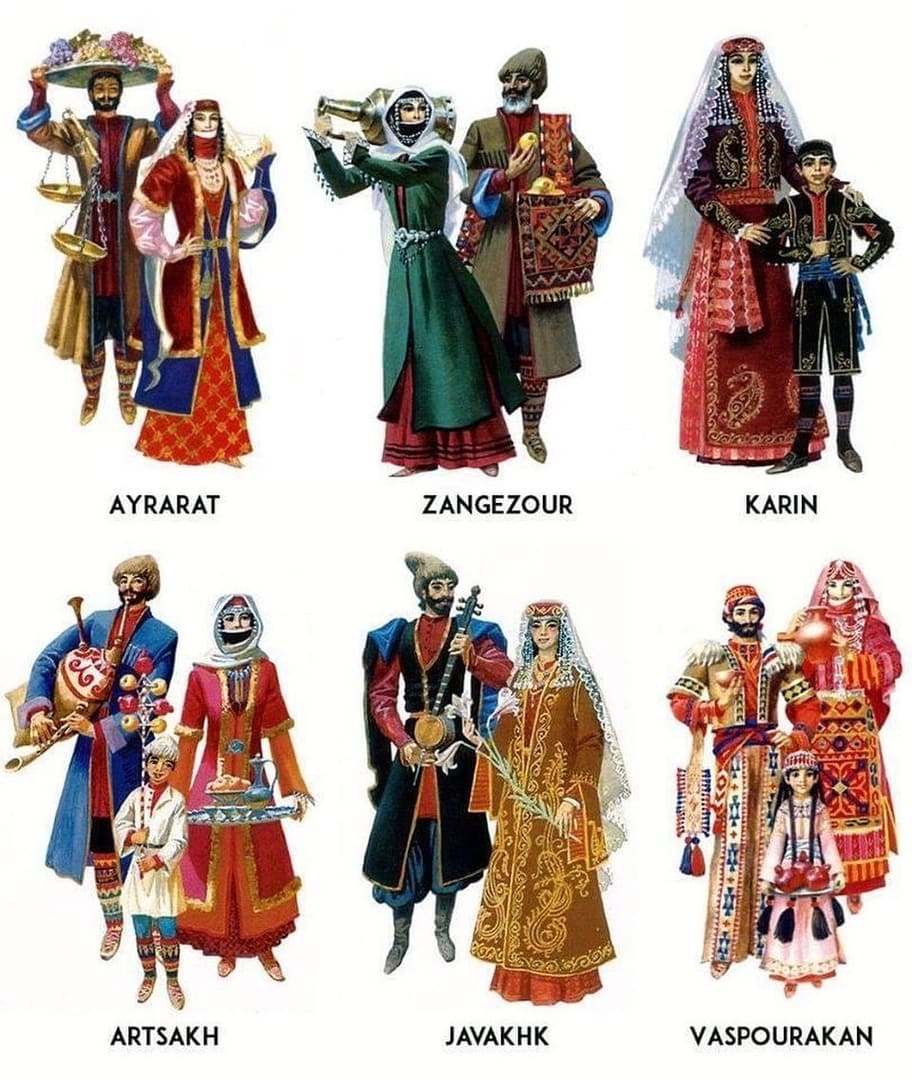
Now people in taraz can be seen at holidays and festivities. National dance and music groups wear them to performances.
Few people know about such a tradition associated with a modern men's suit. Armenian men put on a linen undershirt under any outerwear, even under a T-shirt. It is warmer in winter, and sweat stains do not remain on clothes in summer. We can only say about women that they follow modern European fashion and always look well-groomed.
Traditional dances
Armenians had dances for each event; for example, weddings, funerals, victories in battle or work. Some of them are now performed only by folk groups, but there are dances that today's youth knows and loves. People may gather in parks or squares to dance or learn moves.
War dances include:
Berd—"a fortress". You immediately remember its name when you see the dance. Men stand on each other's shoulders, creating a two-storey wall. Traditionally, the dance is performed by the "Berd" ensemble.
Kochari is associated with the time of worship of a wild ram, whose movements are repeated by the dancers. Now it is a victorious male dance, which even made it to historical film. It was performed in 1945 at the walls of the Reichstag in Berlin.
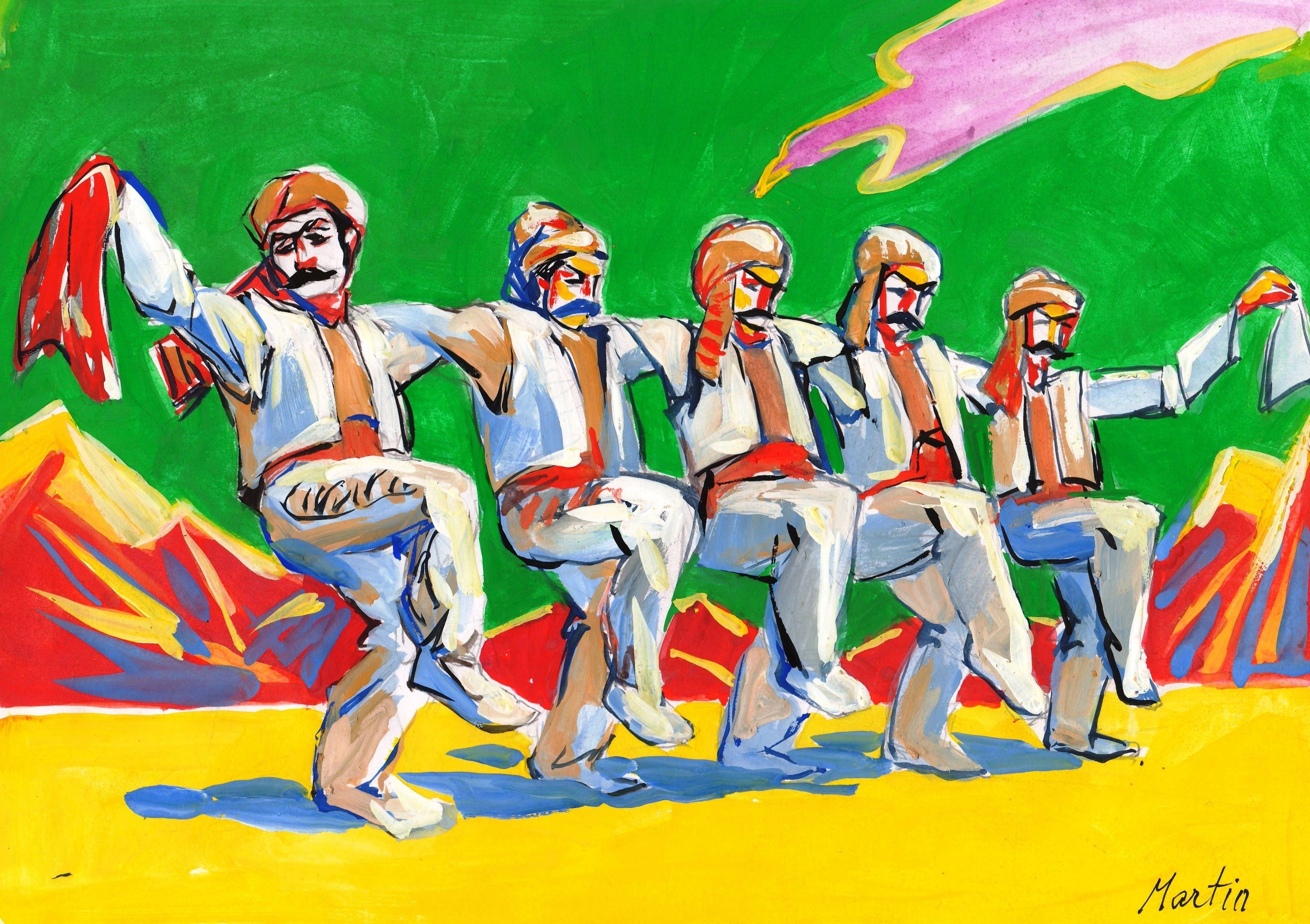
Yarkhushta, which means "comrade in arms" in translation. During the dance, the warriors moved towards each other and loudly clapped their hands.
The bright and impressive Armenian dance with sabers Trakhagh is shown in the ballet "Gayane", music by Aram Khachaturian. This ballet is a real national treasure.
On other occasions they danced:
Shalakho is also performed in the ballet Gayane. It is danced by two men and a woman.
Ververi is a group dance that was previously associated with the cult of the tree, that is, the symbol of offspring.
Performing the Dzheyrani dance, they imitated an antelope: they kept their heads up, walked slowly and moved their arms smoothly.
Papuri was performed by men to scare away forces of evil.
Etchmiadzin, presumably, was dedicated to the god of the sun. People got up in a round dance, narrowed the circle and dispersed.
Wedding dances:
A barbecue dance is performed at a wedding when this dish is served.
The bride has her own dance—Uzundara. She performs alone or with other girls.
Shavali is the dance of the guests at the wedding. It was originally performed by the mother-in-law.
Learn more about dancing in this article.
Folk music
The music was everyday, festive, epic and lyrical. It was performed on folk instruments: duduk (pipe made of apricot wood), kamancha (lyre with a round resonator) and shvi (whistle flute). Nowadays as well, for instance, during the feasts you can hear the chorus of Armenian voices.
In the first half of the XX century. jazz appeared in Armenia. It is considered the most beloved musical genre of Armenians. In many restaurants and cafes in Yerevan at dinner you will hear a local jazz band. IN this article we talked about jazz in Yerevan, and in this – about Armenian musicians and performers in general.
Family traditions
Armenians have many traditions, customs and rituals associated with bright events, both joyful ones, like weddings and christenings, and sad ones, like funerals. There are also unique family holidays. Not everyone follows the traditions, some of them have already been forgotten or transformed. They are more reverently treated in villages, far from big cities.
Wedding
According to this ritual— matchmaking the groom's parents come to the bride's house. The future father-in-law and mother-in-law agree to give up their daughter only from the third time, because they highly appreciate and love her.
Before the wedding Nshandrek —engagement takes place in the bride's house or in a restaurant. The groom gives the bride a ring, which is sometimes blessed in a church. It is believed that after that no one will be able to prevent the marriage. During the feast, they plan a future wedding.
On the day of the wedding, the celebration begins at the groom's house. Guests gather at the table, congratulations are voiced. Then everyone goes to the bride's house. She dances for her loved one while saying goodbye to her parents. A feast is also organized at the bride's house. When they are about to leave, the younger brother of the bride or another boy close to the family blocks the groom's way with a dagger until his godfather pays a ransomfor the bride.
Even nowadays many young couples get married in the church. Sometimes they go only to church, but do not officially reggister their marriage. They exchange rings and put them on the finger of the left hand.
Then they go to the groom's house or to a restaurant. The mother or other relative from the groom's side puts lavash on the couple's shoulders and feeds them with honey. The husband and wife must step on the plates and break them. Traditionally, the man, as the head of the family, does this first. The bride again dances for her beloved along with other young guests. And, as we said, the waiters perform a dance when serving the barbecue.
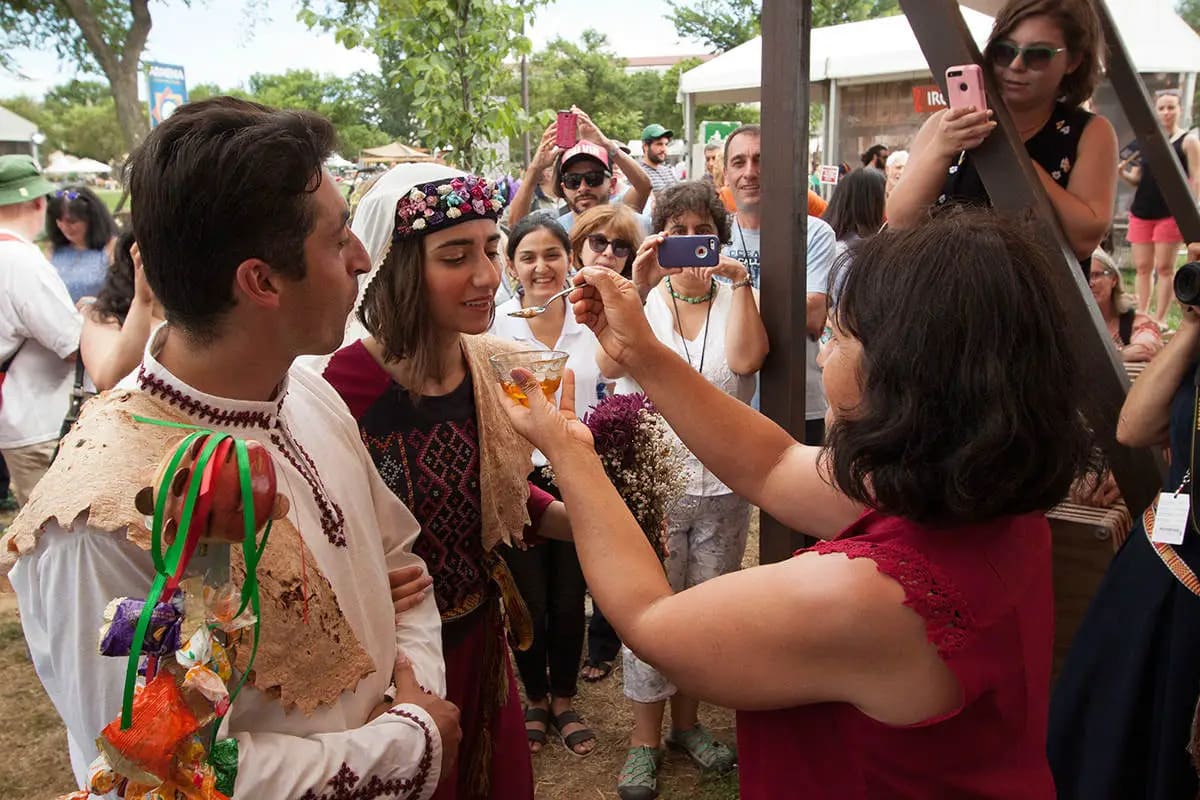
Nobody encourages the couple to kiss during the celebration, as it is considered indecent for newlyweds to show their feelings and kiss in public. The maximum is a kiss on the cheek.
Not only newlyweds are given gifts. They, in their turn, present guests with tarosiks. Taros is translated as "transfer". Traditionally, the bride gave sweets to single guests, thus sharing her happiness. Now they can give flowers and other small souvenirs as a keepsake of the event.
Birth of a child
The appearance of a child in the family is a great joy. Often, happy parents donate money in gratitude to the doctor. There is still a religious tradition, according to which only relatives can see the child 40 days after the birth.
Christening
Only a married couple can become godparents. Note that in the Armenian Church the christening certificate sometimes replaces the birth certificate. If the child was not christened in childhood, this is done before the wedding.
The christening of a child is widely celebrated as a big family holiday, like a wedding or a birthday.
Atamhatik
An unusual Armenian tradition, which is rarely seen in other countries, is associated with the appearance of the child's first tooth. It is called Atamhatik—"tooth" + "seed". Guests are invited to the celebration, the child’s head is sprinkled with peas and beans so that all teeth grow painlessly. Then they conduct a ceremony to choose a future profession for the baby. Things are laid out around him, denoting different activities, whichever child is drawn to, that he will do in the future.

Funeral
There are various beliefs among peoples which are associated with death and burial. In Armenia, in the house of a deceased person, the clock is stopped and mirrors are hung in order to protect themselves from evil forces. When observing mourning, women wear black clothes, men do not shave their beards for 40 days.
According to religious tradition, the number three has a sacred meaning, so sometimes the custom of going around the coffin counterclockwise for three times and kissing the hand of the deceased is preserved. The funeral is held on the third day. All relatives gather. Be sure to leave financial assistance to the family of the deceased. In some villages, women are still forbidden to accompany the deceased to the cemetery.
Khashlama and harisa are put on the memorial table, they drink vodka. The next commemoration takes place on the seventh and fortieth day from the date of teh death.
National holidays and memorial days
In this section we will tell you how hey celebrate memorable dates and holidays, including original ones in Armenia.
New Year
New Year is celebrated from December 31st to January 1st. They decorate the Christmas tree in advance. Today it is a spruce or its paws, but initially they took branches of any trees or ears of wheat. They symbolized the tree of life. They were decorated with fruits, walnuts and homemade dolls. Some families try to keep the old tradition.

This holiday is celebrated with friends and relatives. Fireworks are fired atmidnight. The next three days they visit relatives.
In Armenia, there are two more dates marking the New Year. The memory of them has been preserved since prehistoric times. March 21st was Amanor, or the vernal equinox. And on August 11, the progenitor of the Armenians, Hayk Nahapet, struck down the Babylonian ruler, Titan Bel with one arrow, freeing his people. That memorable day was called Navasard. Now, of course, these are not official holidays.
Christmas
In Armenia, Christmas and Epiphany are celebrated at the same time - from the fifth to the sixth of January. Together, both holidays are called Epiphany. At this time, they go to church, spend time with their families. The festive table is traditionally served with boiled fish, symbolizing Jesus Christ, pilaf with dried fruits, boiled herbs and red wine.
We have separate article about New Year and Christmas in Armenianwe invite you to read.
Terendez
Terendez (Trndez), or the Presentation of the Lord, is celebrated from the evening of February 13th. This is an example of combining a pagan and a Christian holiday. Pagan fire worshipers lit fires and jumped over them to make the sun warmer. The main participants of the holiday were couples. Nowadays, the Day of Blessing of the Newlyweds is also celebrated on this day. From the candle blessed at the divine service a fire is lit through which, as before, couples jump.
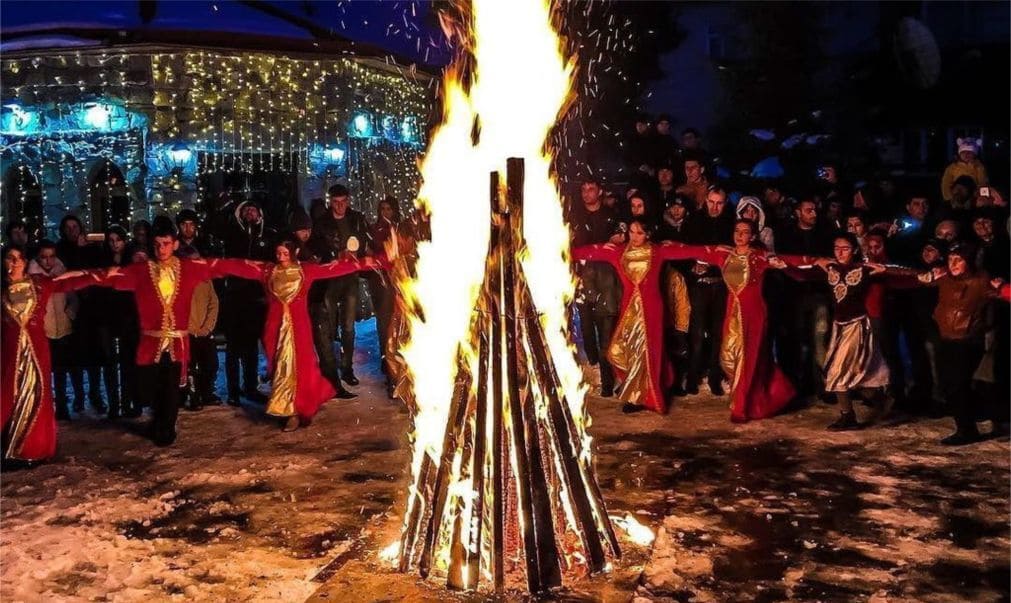
Saint Sarkis Day
Armenia has its own Valentine's Day - St. Sarkis Day. It is celebrated 64 days before Easter, that is, on Saturday between January 18 and February 23. On this day, salty cakes are eaten without drinking water, in order to see their love in a dream who will hand them a glass of water. And they put a tray of fried wheat flour outside. If the horse of St. Sargis leaves its mark on it at night, then the wish of the person in love will come true.
Boon Barekendan
Armenian Maslenitsa is celebrated before the start of Lent. Barekendan not only sees off the winter: the main thing is that this is the day when people come out of mourning, they enjoy life. The title translates as "good life". Folk festivals, fairs are organized, guests are waiting for a feast, but they try to eat food only of plant origin in order to prepare for the upcoming Lent.
Women's Day
March 8 is an official holiday in Armenia. But the celebration does not end with one day. A whole month is devoted to women, until April 7, when they celebrate the Day of Motherhood and Beauty. they remembered about this April holiday, coinciding with the Annunciation of the Most Holy Theotokos, after the collapse of the USSR. The International Women's Day was left non-working, but they do not forget about their own holiday.
Tsaghkazard
Tsaghkazard - “decorated with flowers”, or Palm Sunday, is celebrated on the last Sunday of Great Lent, a week before Easter. In Armenia, willow and olive branches are blessed.
Zatik
On Easter - Zatik, eggs are dyed red with onion skins and exchanged. There is a game in which the opponents fight with eggs, and the winner takes the broken egg of the loser. The egg can be cut, sprinkled with salt and wrapped in pita bread along with tarragon. Instead of Easter cake, they eat gata. Read more about the holiday here.
Day of Remembrance of the Victims of the Armenian Genocide
During the First World War, ethnic Armenians were massacred in the Ottoman Empire. About one and a half million people died poets, composers, doctors, journalists among them. Armenians around the world remember the events of 1915. On April 24, a funeral procession takes place in Yerevan to the Tsitsernakaberd (“Swallow Fortress”) memorial, where flowers are laid. For the centenary of the genocide, an emblem in the form of a purple forget-me-not was created - a symbol of memory.
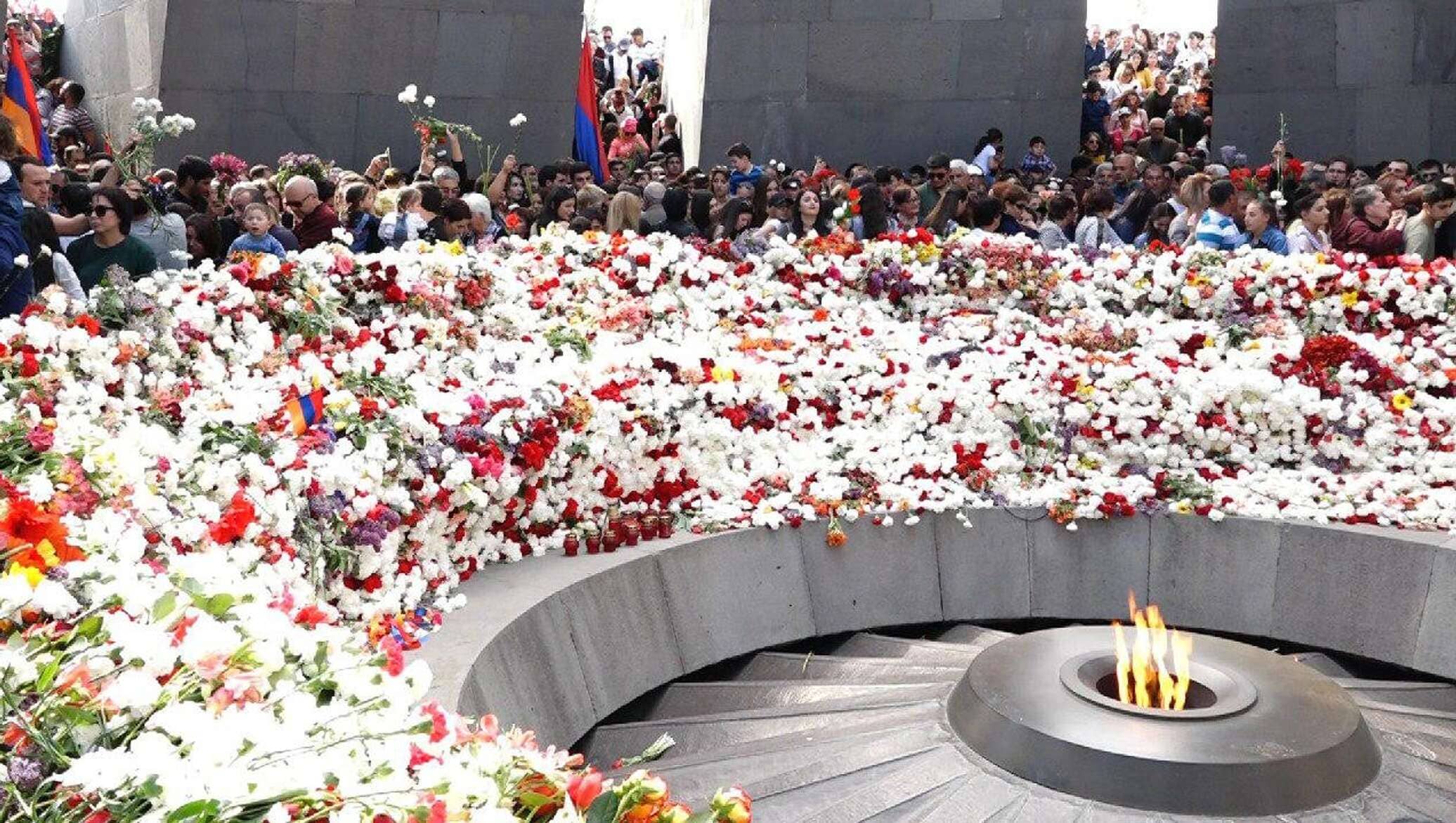
Victory Day
More than 500,000 Armenians fought in the Great Patriotic War, so May 9 is an important date for the country. Every year, flowers are laid at the memorials, the Immortal Regiment campaign is held, and fireworks are arranged.
Vardavar
The pagan holiday of Vardavar has also been preserved, which now coincides with the Transfiguration of the Lord. Celebrated 14 weeks after Easter. Translated from Armenian, Vardavar means “bright, fiery rose.” The holiday was dedicated to the goddess of love and beauty Astghik, beloved of the fire god Vahagn. The goddess gave roses and poured rose water throughout the Armenian land. And now it is customary to pour water on passers-by. More details about the holiday - link.
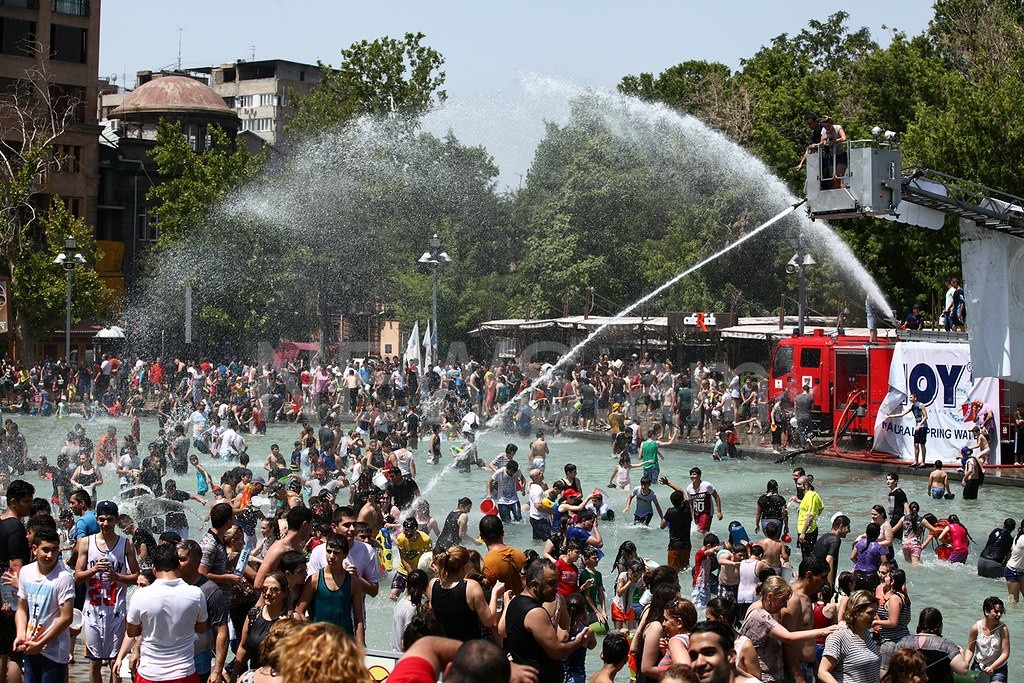
Matah
The ritual that surprises foreigners the most is matah. On a church holiday or after an important event for a person, salt is illuminated in the temple. Outside the church fed to a lamb, calf or red rooster, after which the animal or bird is slaughtered. Boiled meat is distributed to the poor, neighbors, and friends, since the whole essence of this ritual lies precisely in charity, the desire to share one’s joy or sorrow with others.
After getting acquainted with the traditions and customs of the Armenians, we can say that they are an open, sympathetic people who honor their ancestors, love their country and remember history.
If you moved to Armenia and want to learn its history, start learning the language, dance folk dances and cook traditional dishes, follow the announcements of free events Move2Armenia Culture.
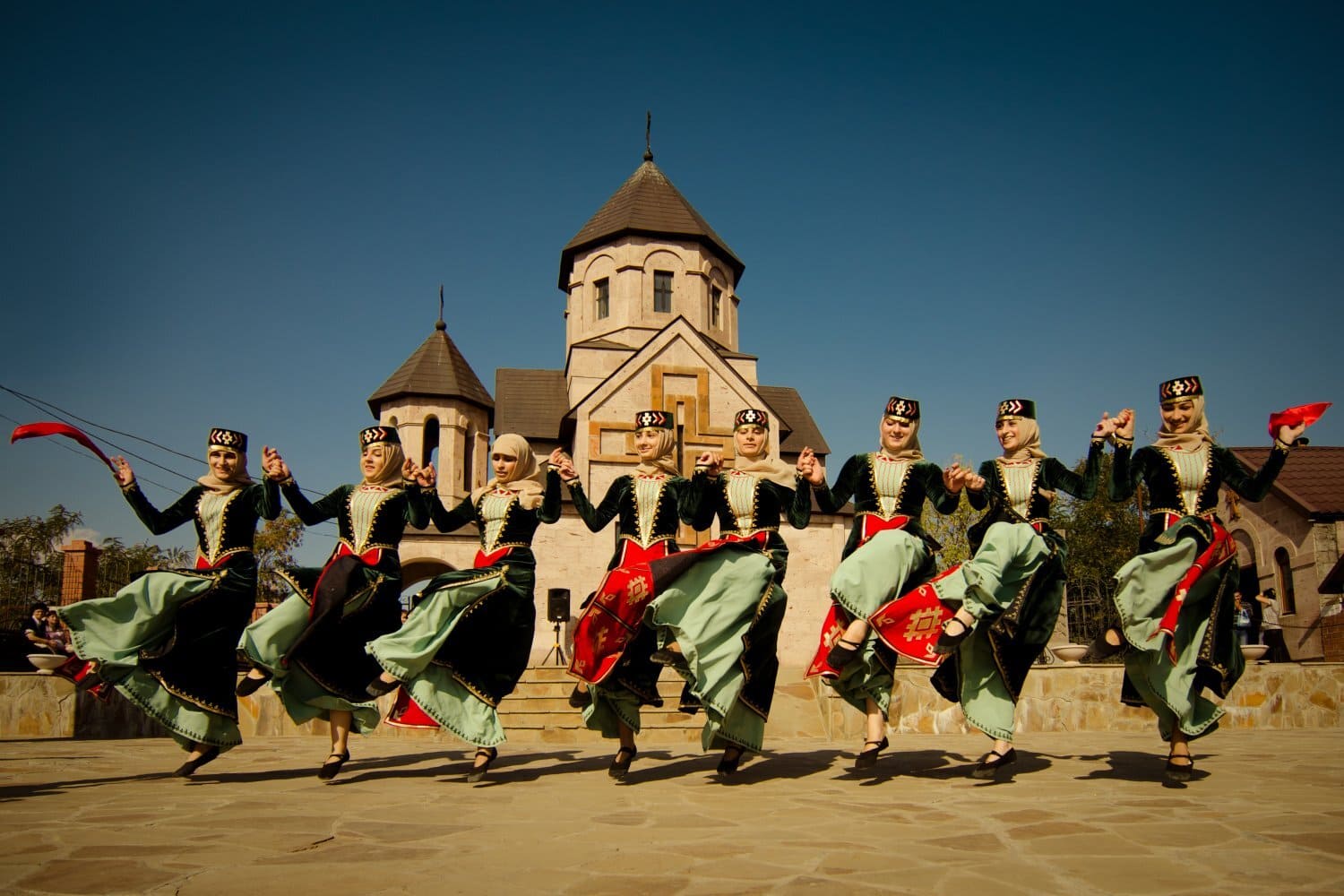






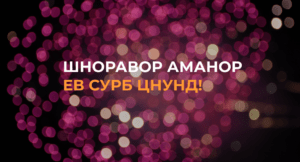






Sherri
28.06.2024 в 16:39continuously i used to read smaller content that as well clear their motive, and that is also
happening with this piece of writing which I am reading at this time.
My page: психология инженерного труда
Marsha
19.06.2024 в 06:34Здесь вы найдете разнообразный видео контент green park ялта интурист
Latoya
30.05.2024 в 03:30youtube new
cordial
13.03.2024 в 14:12A A անց աշխատել և կանայք քbedrom cordial ի մասին գրելիս կանանց իրավունքների ոտնահարումը չդարձնել հայկական անդույթի մի մաս,քանի որ հայկական մշակույթը բնավ այդ մասին չէ
Donna Stephenson
10.01.2024 в 23:25I dated an Armenian man for a long time.Such a gracious culture.Love of family and friends is so admirable.To this day,though years have passed,we are great friends.
Igor
07.07.2023 в 14:21Wherever I come, the first thing I go to eat in a restaurant with local cuisine) I liked the Armenian national dishes. I tried almost everything, the bozbash soup was especially delicious.
Natalia
07.07.2023 в 13:58The attitude of Armenians towards each other and in the family is admirable. It's the foundation of the foundations and always in sight
Add a comment